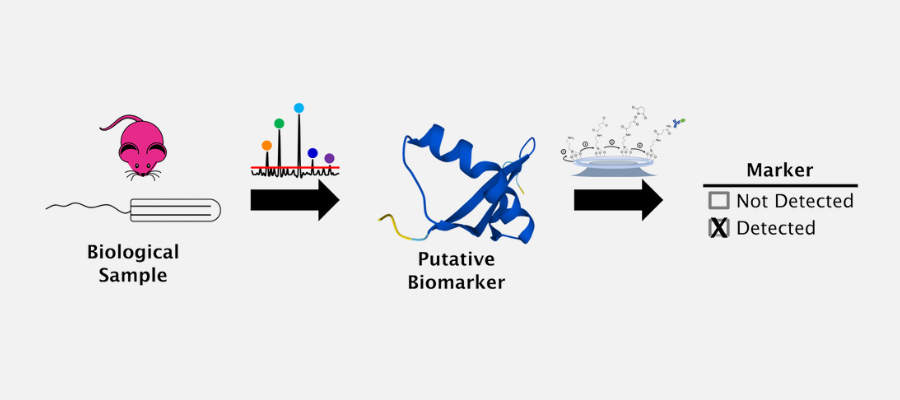New biomarker offers hope for earlier ovarian cancer detection
Ovarian cancer is particularly difficult to detect, as the disease often does not produce significant symptoms until it has reached late stages and caused metastasis. New screening methods would help physicians detect ovarian tumors early and dramatically increase the chances of patient survival.
A study published in Molecular & Cellular Proteomics by past and current University of Illinois Chicago faculty members used a variety of cutting-edge techniques to identify a new biomarker for ovarian cancer that offers hope for effective routine screening — potentially even at home.

While biomarker studies often seek signs of tumor DNA in blood, the research groups of Joanna Burdette, professor of pharmaceutical sciences at the UIC College of Pharmacy, and Laura Sanchez, who moved from UIC to University of California Santa Cruz in 2021, instead looked to the microenvironment near potential tumors.
Researchers collected vaginal samples from mice with ovarian tumors, then used multiple methods such as mass spectrometry — experiments conducted with Stephanie Cologna, UIC associate professor of chemistry — and proteomics technology to find a molecular “fingerprint” of the cancer. The tests identified a potential biomarker in the enzyme cystatin A, which has been previously associated with the body’s immune response to cancer, not the tumor itself.
“I think that’s going to be a very important thing to think about because if we want to detect tumors early, they should be small, maybe even so small that they wouldn’t be detectable if you were just looking for the cancer cell,” said Burdette, who is also a member of the University of Illinois Cancer Center. “But if you look in the environment around the tumor, the immune system, bacteria and other things responding to it, that might be a more robust signal that we could detect earlier.”
The researchers then tested this signal in samples from human patients, using tampons worn by women the day before gynecologic surgery. In samples from patients diagnosed with ovarian cancer, they found that cystatin A levels were twice as high as in the samples diagnosed as benign.
While further trials are needed to verify the predictive power of cystatin A in humans, the paper provides proof of concept that this approach can identify potential biomarkers detectable through routine procedures. Gynecologists could collect vaginal samples during regular checkups or, more speculatively, women could send tampons for laboratory screening on a variety of concerns, similar to new home-screening tests for colon cancer.
“The idea that you could slot this in as part of a routine gynecological exam makes sense to us,” Burdette said. “We can imagine these fingerprints are probably not unique to just cancer, they could also be useful for a variety of women’s health issues, such as vaginal infection, cervical cancer and STDs.”
This article first appeared in UIC Today. Read the original.
Enjoy reading ASBMB Today?
Become a member to receive the print edition four times a year and the digital edition monthly.
Learn moreGet the latest from ASBMB Today
Enter your email address, and we’ll send you a weekly email with recent articles, interviews and more.
Latest in Science
Science highlights or most popular articles

The science of staying strong
Muscles power every movement, but they also tell the story of aging itself. Scientists are uncovering how strength fades, why some species resist it and what lifestyle and molecular clues could help preserve muscle health for life.

Bacteriophage protein could make queso fresco safer
Researchers characterized the structure and function of PlyP100, a bacteriophage protein that shows promise as a food-safe antimicrobial for preventing Listeria monocytogenes growth in fresh cheeses.

Building the blueprint to block HIV
Wesley Sundquist will present his work on the HIV capsid and revolutionary drug, Lenacapavir, at the ASBMB Annual Meeting, March 7–10, in Maryland.

Gut microbes hijack cancer pathway in high-fat diets
Researchers at the Feinstein Institutes for Medical Research found that a high-fat diet increases ammonia-producing bacteria in the gut microbiome of mice, which in turn disrupts TGF-β signaling and promotes colorectal cancer.

Mapping fentanyl’s cellular footprint
Using a new imaging method, researchers at State University of New York at Buffalo traced fentanyl’s effects inside brain immune cells, revealing how the drug alters lipid droplets, pointing to new paths for addiction diagnostics.

Designing life’s building blocks with AI
Tanja Kortemme, a professor at the University of California, San Francisco, will discuss her research using computational biology to engineer proteins at the 2026 ASBMB Annual Meeting.

